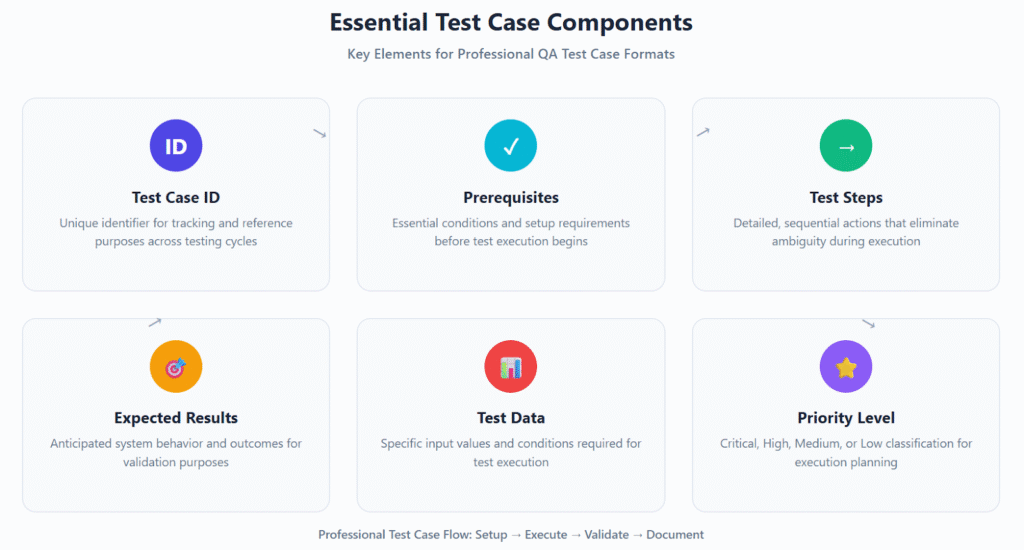Key Takeaways
Key Takeaways
Sample software test cases provide the foundation for systematic quality assurance across all software projects.
- Organizations implementing standardized test case libraries experience 35% fewer critical defects in production environments
- Structured testing approaches can reduce defect remediation costs significantly, as production defects cost 4-8 times more than those caught during development
- Modern AI-enhanced testing systems improve effectiveness by 15-30% through machine learning algorithms and predictive analytics
- Recommendation: Implement a comprehensive library of reusable sample software test cases to accelerate your QA process and maintain testing consistency across projects.
Writing effective test cases is the cornerstone of successful software testing, yet many QA teams struggle with creating comprehensive, reusable test documentation. According to Capgemini's World Quality Report 2024, organizations with standardized test case libraries experience 35% fewer critical defects in production. This comprehensive guide provides you with 15+ sample software test cases, proven QA test case formats, and downloadable templates that your team can implement immediately.
The financial impact of poor test case management is substantial. Research from the Consortium for Information & Software Quality (CISQ) reveals that poor software quality cost the U.S. economy $2.41 trillion in 2024, highlighting the critical importance of effective quality assurance practices. Whether you're testing a banking application's login functionality or validating an e-commerce platform's checkout process, having well-structured sample software test cases accelerates your testing process while ensuring consistent quality standards.
Modern testing approaches are evolving rapidly, with ResearchGate studies demonstrating that AI-enhanced testing systems improve their effectiveness by 15-30% during initial implementation periods. These practical examples demonstrate how professional QA teams document, execute, and manage test cases across various industries and application types.
What Makes an Effective Sample Software Test Case?
Before diving into specific test case examples, understanding the essential components that make sample software test cases effective is crucial. A well-written test case serves as a roadmap that any team member can follow to validate specific functionality, regardless of their familiarity with the application.
Effective sample software test cases include several critical elements that ensure repeatability and clarity. The test case ID provides unique identification for tracking and reference purposes. Clear prerequisites establish the necessary conditions before test execution begins. Detailed test steps break down the validation process into manageable actions that eliminate ambiguity. Expected results define the anticipated system behavior, while actual results capture what actually occurs during execution.

The most valuable sample software test cases also incorporate negative testing scenarios that validate how the system handles invalid inputs or unexpected user behavior. According to defect removal efficiency research, comprehensive test coverage that catches defects early reduces remediation costs significantly, as production defects are 4-8 times more expensive to fix than those identified during development phases.
Which Test Case Formats Work Best for Different Project Types?
Different project types require tailored approaches to test case documentation. Understanding which QA test case formats align with your specific testing needs can dramatically improve your team's efficiency and test coverage.
For agile development teams, simplified test case examples that focus on user stories and acceptance criteria work exceptionally well. These formats emphasize behavior-driven testing that validates functionality from the end-user perspective. Traditional waterfall projects often benefit from more detailed documentation that includes extensive prerequisite setup and comprehensive step-by-step procedures.
API testing projects require specialized sample software test cases that focus on request/response validation, status codes, and data integrity checks. Mobile application testing demands test case examples that account for device-specific behaviors, network conditions, and platform variations. Web application testing needs comprehensive scenarios covering browser compatibility, responsive design, and cross-platform functionality.
Modern QA teams are increasingly leveraging Generative AI agents that can interpret user stories and acceptance criteria to automatically draft comprehensive test cases. Unlike traditional predictive models, these AI-powered engines can analyze requirements from tools like Jira or GitHub and generate production-ready test steps, identifying edge cases and potential failure points that might be missed during manual documentation.
The following table compares different QA test case formats based on project requirements:
| Project Type | Recommended Format | Key Focus Areas | Documentation Level |
| Agile Web Apps | User Story Based | Acceptance Criteria, User Behavior | Medium |
| Enterprise Software | Comprehensive Template | Detailed Steps, Traceability | High |
| Mobile Apps | Device-Specific Format | Platform Testing, Performance | Medium |
| API Testing | Request/Response Format | Data Validation, Status Codes | Low-Medium |
| Security Testing | Risk-Based Template | Vulnerability Assessment, Compliance | High |
How Do You Structure Login Test Cases for Maximum Coverage?
Login functionality represents one of the most critical areas requiring comprehensive sample software test cases. These test case examples must cover both positive and negative scenarios while addressing security considerations that protect user accounts and sensitive data.

A complete set of login test case examples should validate successful authentication with valid credentials, appropriate error handling for invalid inputs, and security measures like account lockout protection. These sample software test cases also need to verify password complexity requirements, session management, and multi-factor authentication when applicable.
Here are five essential login test case examples that every application should include:
Test Case 1: Valid Login Credentials
- Test ID: LOGIN_001
- Description: Verify successful login with valid username and password
- Prerequisites: User account exists with valid credentials
- Test Steps:
- Navigate to login page
- Enter valid username in username field
- Enter valid password in password field
- Click Login button
- Expected Result: User successfully logs in and redirects to dashboard
- Priority: High
Test Case 2: Invalid Password Handling
- Test ID: LOGIN_002
- Description: Verify error message display for incorrect password
- Prerequisites: User account exists with valid username
- Test Steps:
- Navigate to login page
- Enter valid username
- Enter incorrect password
- Click Login button
- Expected Result: Error message displays "Invalid username or password"
- Priority: High
What Sample Test Cases Cover E-commerce Functionality?
E-commerce applications require extensive sample software test cases that cover the complete customer journey from product browsing through purchase completion. These test case examples must validate complex workflows while ensuring payment security and inventory accuracy.
Critical e-commerce test case examples include product search functionality, shopping cart management, checkout processes, and payment gateway integration. Each sample software test case should account for different user scenarios, including guest checkout, registered user purchases, and various payment methods.
Professional test case management platforms provide essential capabilities for organizing and executing complex e-commerce testing scenarios efficiently.
Test Case 3: Add Product to Cart
- Test ID: CART_001
- Description: Verify product addition to shopping cart
- Prerequisites: User logged in, product available in inventory
- Test Steps:
- Navigate to product catalog
- Select specific product
- Choose quantity and options
- Click "Add to Cart" button
- Verify cart icon updates with item count
- Expected Result: Product appears in cart with correct details and quantity
- Priority: Critical
Test Case 4: Checkout Process Validation
- Test ID: CHECKOUT_001
- Description: Verify complete checkout process with valid payment
- Prerequisites: Items in cart, valid payment method available
- Test Steps:
- Navigate to shopping cart
- Click "Proceed to Checkout"
- Enter shipping information
- Select payment method
- Review order summary
- Submit order
- Expected Result: Order confirmation displayed with transaction ID
- Priority: Critical
How Do Mobile App Test Cases Differ from Web Applications?
Mobile application testing requires specialized sample software test cases that address unique challenges like device fragmentation, network connectivity variations, and platform-specific behaviors. These test case examples must account for touch gestures, device orientations, and mobile-specific features like push notifications.

Effective mobile test case examples validate functionality across different screen sizes, operating system versions, and hardware capabilities. Sample software test cases for mobile apps also need to address performance considerations like battery usage, memory consumption, and data usage optimization.
Test Case 5: Device Rotation Handling
- Test ID: MOBILE_001
- Description: Verify app behavior during device orientation change
- Prerequisites: Mobile app installed and launched
- Test Steps:
- Open application in portrait mode
- Navigate to main screen
- Rotate device to landscape mode
- Verify layout adjustment
- Rotate back to portrait mode
- Expected Result: App maintains functionality and proper layout in both orientations
- Priority: Medium
Test Case 6: Network Connectivity Testing
- Test ID: MOBILE_002
- Description: Verify app behavior with poor network conditions
- Prerequisites: Mobile app installed with network access
- Test Steps:
- Launch application with strong WiFi connection
- Navigate to data-dependent feature
- Switch to cellular data with weak signal
- Attempt to refresh or load new content
- Observe loading behavior and error handling
- Expected Result: App displays appropriate loading indicators and graceful error messages
- Priority: High
What API Test Cases Should Every QA Team Include?
API testing requires focused sample software test cases that validate data exchange, response codes, and system integration points. These test case examples must verify both successful data transactions and appropriate error handling for various failure scenarios.
Comprehensive API test case examples should cover different HTTP methods, authentication mechanisms, and data validation scenarios. Sample software test cases for APIs also need to address performance requirements, rate limiting, and security considerations that protect against malicious requests.
Test Case 7: GET Request Validation
- Test ID: API_001
- Description: Verify successful GET request returns expected data
- Prerequisites: API endpoint available, valid authentication token
- Test Data: Valid user ID parameter
- Test Steps:
- Send GET request to /api/users/{userID}
- Include authentication headers
- Verify response status code
- Validate response data structure
- Check response time
- Expected Result: 200 status code with complete user data in JSON format
- Priority: High
Test Case 8: POST Request with Invalid Data
- Test ID: API_002
- Description: Verify API handles invalid POST data appropriately
- Prerequisites: API endpoint available for user creation
- Test Data: JSON payload with missing required fields
- Test Steps:
- Send POST request to /api/users
- Include payload missing required email field
- Verify response status code
- Check error message content
- Expected Result: 400 status code with descriptive error message
- Priority: Medium
How Do You Create Database Test Cases?
Database testing requires specialized sample software test cases that validate data integrity, transaction processing, and query performance. These test case examples must ensure that data operations maintain consistency while meeting performance requirements under various load conditions.
Effective database test case examples cover CRUD operations (Create, Read, Update, Delete), transaction rollback scenarios, and data validation rules. Sample software test cases for database testing also need to address backup and recovery procedures, data migration scenarios, and concurrent access handling.
Test Case 9: Data Insert Validation
- Test ID: DB_001
- Description: Verify successful data insertion with valid values
- Prerequisites: Database connection established, table structure defined
- Test Data: Valid user record with all required fields
- Test Steps:
- Connect to test database
- Execute INSERT statement with test data
- Verify record insertion success
- Query table to confirm data presence
- Validate all field values match input
- Expected Result: Record successfully inserted with correct values
- Priority: High
Test Case 10: Constraint Violation Handling
- Test ID: DB_002
- Description: Verify database properly handles constraint violations
- Prerequisites: Database with defined constraints (unique, foreign key)
- Test Data: Record that violates unique constraint
- Test Steps:
- Attempt to insert duplicate record
- Capture database response
- Verify transaction rollback
- Confirm original data remains unchanged
- Expected Result: Database returns constraint violation error, no data corruption
- Priority: High
What Security Test Cases Protect Against Common Vulnerabilities?
Security testing demands comprehensive sample software test cases that validate application defenses against common attack vectors and ensure compliance with security standards. These test case examples must cover authentication, authorization, data encryption, and input validation mechanisms.
Critical security test case examples include SQL injection prevention, cross-site scripting (XSS) protection, and session management validation. Sample software test cases for security testing also need to address password policy enforcement, privilege escalation prevention, and secure data transmission protocols.
Test Case 11: SQL Injection Prevention
- Test ID: SEC_001
- Description: Verify application prevents SQL injection attacks
- Prerequisites: Application with database connectivity
- Test Data: Malicious SQL injection payload
- Test Steps:
- Navigate to login form
- Enter SQL injection string in username field: admin'; DROP TABLE users;--
- Enter any value in password field
- Submit form
- Verify database remains intact
- Expected Result: Application rejects input, database structure unchanged
- Priority: Critical
Test Case 12: Password Policy Enforcement
- Test ID: SEC_002
- Description: Verify password complexity requirements are enforced
- Prerequisites: User registration form available
- Test Data: Various weak password combinations
- Test Steps:
- Navigate to registration form
- Enter weak password (e.g., "123456")
- Attempt to submit form
- Verify error message displays
- Test with compliant password
- Expected Result: Weak passwords rejected with specific requirements displayed
- Priority: High
Which Performance Test Cases Identify Bottlenecks?
Performance testing requires targeted sample software test cases that validate system behavior under various load conditions and identify potential bottlenecks before they impact user experience. These test case examples must simulate realistic usage patterns while monitoring key performance indicators.

Effective performance test case examples cover load testing, stress testing, and endurance testing scenarios that reveal how applications handle increasing user volumes. Sample software test cases for performance testing also need to address response time requirements, resource utilization monitoring, and scalability validation across different infrastructure configurations.
Modern testing automation benefits include significant performance improvements, with automated testing enabling faster feedback cycles and more comprehensive coverage of performance scenarios.
Test Case 13: Load Response Time Validation
- Test ID: PERF_001
- Description: Verify page load times under normal user load
- Prerequisites: Application deployed in test environment
- Test Configuration: 100 concurrent users, 5-minute duration
- Test Steps:
- Configure load testing tool for 100 virtual users
- Set scenario to browse product catalog
- Execute load test for 5 minutes
- Monitor response times for key pages
- Capture resource utilization metrics
- Expected Result: Average response time remains under 3 seconds for all pages
- Priority: High
Test Case 14: Memory Leak Detection
- Test ID: PERF_002
- Description: Verify application doesn't exhibit memory leaks during extended use
- Prerequisites: Application monitoring tools configured
- Test Configuration: Extended 8-hour test duration
- Test Steps:
- Start application with baseline memory measurement
- Execute repeated user workflows for 8 hours
- Monitor memory usage trends
- Check for continuous memory growth
- Analyze garbage collection patterns
- Expected Result: Memory usage stabilizes without continuous growth
- Priority: Medium
Essential Sample Software Test Cases for Different Industries
Different industries require specialized sample software test cases that address unique regulatory requirements, business processes, and user expectations. Understanding industry-specific testing needs helps QA teams create more targeted and effective test documentation.
Healthcare applications need sample software test cases that validate HIPAA compliance, patient data security, and clinical workflow accuracy. Financial services require test case examples that ensure transaction security, regulatory compliance, and fraud detection capabilities. Educational platforms demand comprehensive testing that covers user accessibility, content delivery, and assessment functionality.
The transition from spreadsheets to professional test management tools becomes critical when managing industry-specific test cases that require complex traceability and compliance documentation.
Manufacturing systems require sample software test cases that validate inventory management, production tracking, and quality control processes. Retail applications need comprehensive testing that covers point-of-sale functionality, inventory synchronization, and customer data management across multiple channels.
Test Case 15: Multi-System Integration Workflow
- Test ID: INT_001
- Description: Verify end-to-end order processing across integrated systems
- Prerequisites: CRM, inventory, and payment systems operational
- Test Steps:
- Create customer order in CRM system
- Verify inventory deduction in warehouse management system
- Process payment through payment gateway
- Confirm order status updates across all systems
- Validate email notifications sent to customer
- Expected Result: Order successfully processed with consistent data across all systems
- Priority: Critical
How Does TestQuality Streamline Sample Test Case Management?
While templates provide a solid starting point, modern AI agents have transformed the way QA teams build their libraries. TestQuality has evolved beyond traditional management into an AI-Powered QA platform, featuring TestStory.ai—a specialized test case generator designed to eliminate manual documentation overhead.
Instead of writing test cases from scratch, TestQuality’s QAMind AI engine (powered by Google Gemini) allows you to generate high-quality manual test cases directly from your Jira, GitHub, or Linear user stories and epics. The AI agent analyzes your acceptance criteria and instantly structures them into detailed test steps with expected results, covering both happy paths and complex edge cases.
Key capabilities for modern QA teams include:
- Zero-Training Privacy: The built-in AI model does not use your stories or data for training, ensuring your proprietary information remains secure.
- Model Flexibility (BYOK): Teams with strict compliance policies can "Bring Your Own Key" to use OpenAI or Anthropic models alongside TestQuality’s native engine.
- Seamless Integration: Generated test cases are automatically formatted and organized within your test plan, ready for execution or automated analysis
The platform's real-time collaboration features ensure that all team members work with the most current test case examples, eliminating version conflicts and reducing documentation overhead. Advanced reporting capabilities provide visibility into test coverage, execution results, and quality metrics that drive continuous improvement initiatives.
Professional QA teams increasingly rely on effective test case writing practices that combine standardized templates with intelligent automation capabilities for maximum efficiency.
Implementing Your Sample Test Case Library
Building an effective library of sample software test cases requires strategic planning and consistent execution across your entire QA organization. Start by identifying the most critical application areas that require comprehensive test coverage, then develop standardized test case examples that address both positive and negative scenarios for each functional area.
Establish clear naming conventions and organizational structures that make it easy for team members to locate and reuse relevant test case examples. Regular review and updates ensure that your sample software test cases remain current with application changes and evolving business requirements.
Consider implementing automated validation tools that can execute your sample software test cases as part of continuous integration pipelines, providing immediate feedback on code changes and maintaining consistent quality standards throughout the development process.
Frequently Asked Questions
What's the difference between test cases and test scenarios? Test scenarios provide high-level descriptions of functionality to be tested, while test cases contain detailed step-by-step procedures with specific inputs and expected outputs for validation.
How many test cases should I write for each feature? The number depends on feature complexity, but typically include 3-5 positive test cases and 2-3 negative test cases per major feature, plus edge cases and integration scenarios.
Should test cases include actual test data values? Yes, effective test cases specify exact input values, expected outputs, and test conditions to ensure repeatability and eliminate ambiguity during test execution.
How often should sample test cases be updated? Review and update test cases whenever requirements change, new defects are discovered, or application functionality is modified to maintain accuracy and relevance.
Can AI help generate test cases to avoid starting from a blank page?
Yes. AI assisted tools like TestStory.ai are designed to help teams overcome the blank page problem by generating draft test cases from existing inputs such as requirements, user stories, or issue descriptions. These AI generated test cases provide a structured starting point that testers can review, refine, and expand, significantly reducing the time spent on initial test case creation.
Can sample test cases be automated?
Many sample test cases can be converted into automated tests, especially those with clear steps, predictable inputs, and expected outcomes. TestQuality supports this by allowing teams to manage test definitions that can be executed either through automation frameworks or by human testers, depending on the testing approach and scenario.
Maximize Your Testing Efficiency with Professional Test Case Management
Effective sample software test cases form the foundation of successful QA programs, enabling teams to deliver higher quality software while reducing testing costs and accelerating development cycles. By implementing standardized test case examples and leveraging modern test management tools, your organization can achieve significant improvements in both testing efficiency and software quality outcomes.
The comprehensive sample software test cases and QA test case formats presented in this guide provide practical starting points that you can immediately adapt for your specific testing requirements. Remember that the most valuable test documentation evolves continuously based on lessons learned and changing application requirements.
Ready to accelerate your testing process with AI agents? TestQuality’s unified platform combines professional-grade management with the power of TestStory.ai, enabling you to generate, organize, and execute tests in a fraction of the time. whether you are importing stories from Jira or building a regression suite from scratch, leverage our AI-powered QA workflow to drive consistent quality outcomes across all your software projects





